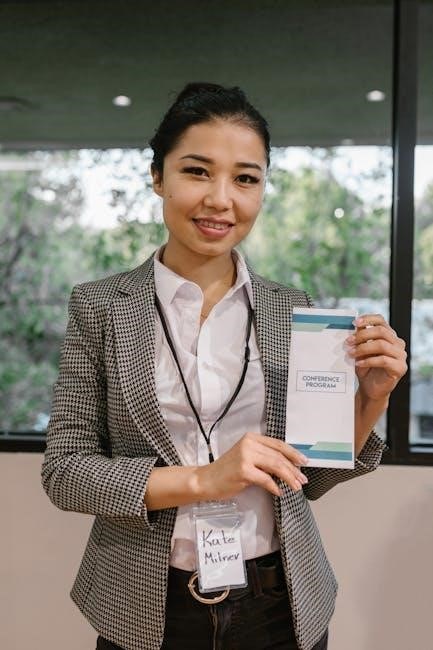Explore Mark Twain’s timeless tale through a comprehensive PDF guide, offering detailed questions and answers to enhance understanding of themes, characters, and plot twists in The Prince and the Pauper․
Overview of the Novel and Its Significance
Mark Twain’s The Prince and the Pauper is a captivating tale of identity, social class, and morality, set in 16th-century England․ The story follows two boys—Prince Edward and Tom Canty—who exchange lives, exploring themes of justice, inequality, and self-discovery․ This novel is significant for its historical context, blending fiction with real events, and its critique of societal hierarchies․ Twain’s vivid portrayal of contrasting worlds highlights universal lessons about humanity and ethics․ The novel’s enduring relevance lies in its ability to engage readers with its timeless themes, making it a valuable study subject․ The PDF guide provides a detailed analysis, aiding students in understanding the novel’s depth and complexity․
Importance of Study Guides and Question Banks
Study guides and question banks are invaluable tools for understanding The Prince and the Pauper․ They provide structured summaries, analysis, and practice questions, helping students grasp key themes and plot points․ These resources are particularly useful for exam preparation, offering insights into characters like Prince Edward and Tom Canty․ By addressing frequently asked questions, they clarify complex concepts and deepen comprehension of Twain’s narrative techniques․ The PDF guide serves as a comprehensive resource, ensuring students are well-prepared for assessments and fostering a deeper appreciation for the novel’s historical and literary significance․ Regular use of such materials enhances critical thinking and analytical skills, essential for academic success․

Major Themes Explored in “The Prince and the Pauper”
The novel delves into themes of identity, social class, and justice, while highlighting moral lessons and the impact of inequality on society, offering profound insights into human nature and ethics․
Identity and Social Class
In The Prince and the Pauper, Mark Twain examines how identity is shaped by social class․ The novel highlights the stark contrast between the lives of the prince and the pauper, illustrating how societal expectations and class distinctions influence individual self-perception․ Through their role reversal, Twain reveals that true identity transcends external appearances and titles․ The characters’ experiences demonstrate that social class can both empower and constrain, often dictating opportunities and treatment․ This theme encourages readers to reflect on the societal structures that define identity and the consequences of class-based inequalities․ The exploration of identity and class remains a powerful commentary on human society, making the novel a timeless reflection of universal social issues․
Moral Lessons and Ethics
The Prince and the Pauper offers profound moral lessons on honesty, kindness, and fairness․ Through their experiences, both characters learn the value of empathy and understanding․ The novel emphasizes the importance of ethical behavior, as seen in the prince’s compassion toward the poor and Tom’s integrity despite his newfound power․ Twain critiques the exploitation of the underprivileged, highlighting the need for moral accountability․ These lessons underscore the universal relevance of treating others with respect and dignity, regardless of social status․ The novel’s ethical themes remain a vital part of its enduring appeal, encouraging readers to reflect on their own values and actions․ The moral core of the story continues to inspire and educate audiences today․
The Prince and the Pauper vividly portrays the stark contrasts of justice and inequality in a stratified society․ The novel exposes the harsh realities faced by the poor, such as unjust laws and social discrimination․ Mark Twain critiques the systemic oppression, highlighting how the privileged few exploit the marginalized․ Through the characters’ experiences, the story demonstrates how inequality perpetuates injustice, preventing individuals from realizing their potential․ The exchange between the prince and the pauper serves as a powerful metaphor for the need to address these disparities․ Twain’s exploration of these themes challenges readers to consider the moral implications of societal structures and the importance of advocating for fairness and equality․ The novel remains a compelling commentary on justice and inequality, resonating across generations․ The story revolves around Prince Edward and Tom Canty, two boys who exchange identities․ Supporting characters include Tom’s father, a pauper, and other figures shaping their journeys․ Prince Edward and Tom Canty are central characters whose lives intertwine through a chance encounter․ Prince Edward, born into royalty, initially struggles with the privileges and responsibilities of his position․ In contrast, Tom Canty, a pauper, aspires to a life beyond his impoverished circumstances․ Their exchange of identities forces each to navigate unfamiliar worlds, revealing striking differences in their adaptability and character․ While Edward adapts to the freedom of a commoner’s life, Tom faces the rigidity of royal etiquette․ This swap highlights their resilience and the societal contrasts of their time, ultimately leading to mutual growth and understanding․ Supporting characters in The Prince and the Pauper play pivotal roles in advancing the plot and developing themes․ John Canty, Tom’s father, exemplifies the harsh realities of poverty, while Lord Hertford and Lord St․ John represent the nobility’s complexity․ Humphrey Marlow, the whipping boy, highlights the cruelties of royal life․ These characters not only shape the protagonists’ journeys but also provide insights into the social hierarchy and moral dilemmas of the era․ Their interactions with Edward and Tom underscore the novel’s exploration of identity, class, and justice, enriching the narrative with depth and nuance․ Each character’s role contributes uniquely to the story’s enduring appeal and thematic richness․ The story follows Prince Edward and Tom Canty as they exchange lives, exploring themes of identity and social class․ Key events drive the narrative forward, revealing moral dilemmas and societal inequalities, while critical analysis highlights Mark Twain’s commentary on justice and humanity․ The exchange of roles between Prince Edward and Tom Canty is sparked by curiosity and a desire for adventure․ The prince, fascinated by the life of commoners, and Tom, longing to escape poverty, decide to swap clothes and identities․ This switch leads to a series of challenges as each boy navigates a world unfamiliar to them․ The prince faces harsh realities of poverty and injustice, while Tom struggles with the responsibilities of royal life․ Their experiences reveal the deep social and economic divides of the time․ Ultimately, the exchange exposes the flaws in the social system and highlights the theme of identity versus circumstance․ The consequences of their actions drive the plot forward, leading to a deeper understanding of justice and equality․ The story unfolds with pivotal moments that shape the narrative․ The initial meeting of Prince Edward and Tom Canty sets the stage, while their decision to exchange clothes initiates the central conflict․ The prince’s struggle to adapt to Tom’s impoverished life and Tom’s challenges in assuming royal duties create tension․ The recognition of the Great Seal by the prince and the eventual switching back of roles are crucial turning points․ These events highlight themes of identity, class, and justice, propelling the story toward its resolution․ Each key event deepens character development and underscores the novel’s exploration of social inequality and moral growth, making them essential to the plot’s progression and thematic depth․ Engage with multiple-choice and open-ended questions covering key events, character motivations, and themes from the early chapters․ Answers provide clarity on plot twists, such as the prince-pauper exchange and Tom’s experiences․ The PDF guide features a variety of multiple-choice and open-ended questions designed to test comprehension and critical thinking․ Multiple-choice questions focus on key events, character identities, and thematic elements, such as the exchange between Prince Edward and Tom Canty․ Open-ended questions encourage deeper analysis, prompting readers to explain motivations, like why Tom Canty’s father is a pauper or how historical references enhance the story․ These questions cover Chapters 1-8, addressing plot twists, moral lessons, and societal themes․ Answers are provided to help students verify their understanding and retain key details effectively․ This mix of question types ensures a comprehensive grasp of the novel’s complexities and relevance․ The PDF guide provides clear and concise answers to frequently asked questions about The Prince and the Pauper․ It addresses key queries, such as how the prince and pauper swap identities, why Tom Canty’s father is a pauper, and the significance of King Henry VIII’s health in the plot․ Additionally, it clarifies how the characters’ motivations and actions drive the story, including Tom’s journey from poverty to royalty and the prince’s lessons in humility․ These answers help readers grasp the novel’s central themes, such as social class and justice, while also explaining historical references and their impact on the narrative․ This section ensures a deeper understanding of the story’s complexities and moral lessons․ Mark Twain’s The Prince and the Pauper incorporates historical references to 16th-century England, enhancing the story’s authenticity and providing context for its themes of class and justice․ Mark Twain skillfully weaves historical references into The Prince and the Pauper, drawing from 16th-century England․ The novel mentions King Henry VIII and his legal reforms, which are central to the plot․ Twain’s attention to historical detail, such as architecture, clothing, and social hierarchies, adds authenticity․ While the story is fictional, its historical backdrop makes the prince-pauper exchange plausible․ Twain’s use of real historical figures and events enriches the narrative, blending fact and fiction seamlessly․ This approach not only enhances the story’s credibility but also deepens its exploration of themes like class and justice, making the novel a compelling blend of history and imagination․ The historical context of 16th-century England in The Prince and the Pauper enriches the narrative by providing a backdrop of strict social hierarchies and royal politics․ This setting allows Twain to explore themes like inequality and justice through the contrasting lives of a prince and a pauper․ The historical references, such as the reign of King Henry VIII, add depth and authenticity, making the characters’ experiences more relatable․ The rigid class system of the time underscores the challenges faced by Tom Canty and Prince Edward, highlighting the social commentary central to the novel․ By grounding the story in a specific historical era, Twain creates a vivid and immersive world that enhances the emotional impact of the tale․ Utilize study guides and PDF resources for in-depth analysis․ Create a study schedule, engage in active reading, and practice with chapter-wise questions to master the material effectively․ To excel in exams on The Prince and the Pauper, adopt a structured approach․ Begin by thoroughly reading the novel, highlighting key themes, characters, and events․ Use the PDF study guide to focus on chapter-wise questions and answers, ensuring comprehension of critical points․ Create a study schedule, breaking down the syllabus into manageable sections․ Regularly review summaries and concept maps to reinforce understanding․ Engage in active learning by answering practice questions and discussing themes with peers or teachers․ Stay organized, dedicating specific spaces for study to minimize distractions․ Consistent revision and timely clarification of doubts will build confidence and readiness for exams․ Enhance your preparation with curated PDF guides tailored for The Prince and the Pauper․ These resources include chapter-by-chapter summaries, multiple-choice questions, and open-ended prompts to test comprehension․ Many guides offer answers to frequently asked questions, ensuring clarity on complex themes like identity and social class․ Some PDFs include historical context to deepen understanding of Mark Twain’s narrative․ Additionally, study materials often feature detailed character analyses and plot breakdowns, helping students grasp the novel’s nuances․ Utilize these tools to improve retention, identify knowledge gaps, and refine exam strategies․ They are invaluable for both individual study and classroom discussions, providing a comprehensive approach to mastering the novel․ The Prince and the Pauper remains relevant today, offering insights into social inequality, identity, and ethics․ Its themes resonate with contemporary issues, inspiring reflection on societal justice and individual worth․ Mark Twain’s The Prince and the Pauper offers timeless lessons for modern society, highlighting issues like social inequality and identity․ The novel’s exploration of class divides and moral ethics remains relevant, encouraging readers to reflect on justice and fairness․ Its portrayal of two boys navigating different worlds underscores the impact of environment and circumstance on identity, a theme that resonates today․ The story also emphasizes empathy and understanding, urging individuals to see beyond superficial differences․ By examining historical contexts, the novel provides insights into how societal structures shape opportunities and challenges․ These lessons inspire contemporary discussions on equality, morality, and the importance of compassion in addressing societal inequities․ Mark Twain’s The Prince and the Pauper has been adapted into numerous films, stage plays, and TV series, cementing its place in popular culture․ Notable adaptations include the 1937 film starring Errol Flynn and the 2000 movie featuring a modern twist․ These interpretations have brought the story to new audiences, highlighting its timeless themes of identity and social class․ The novel’s influence is also seen in references and parodies across various media, showcasing its enduring relevance․ Additionally, study guides like the questions and answers PDF provide insights into these adaptations, helping readers analyze how different interpretations enhance the original narrative․ The Prince and the Pauper Questions and Answers PDF serves as an invaluable resource for understanding Twain’s classic, offering insights and fostering deeper appreciation of its timeless themes․ The Prince and the Pauper remains a captivating exploration of identity, class, and morality, offering timeless lessons for readers․ The Questions and Answers PDF provides a structured approach to understanding the novel, making it an essential tool for students and enthusiasts alike․ By engaging with chapter-by-chapter queries and detailed explanations, readers can deepen their grasp of Twain’s themes and character dynamics․ The study guide not only simplifies complex concepts but also encourages critical thinking about historical context and modern relevance․ For anyone seeking to master the novel or prepare for exams, this resource is invaluable, fostering a richer appreciation of Twain’s enduring masterpiece․ Delving into The Prince and the Pauper offers a rewarding journey through themes of identity, class, and morality, enriched by Mark Twain’s vivid storytelling․ The Questions and Answers PDF serves as an excellent companion, guiding readers to explore deeper connections between characters and plot․ For those eager to expand their understanding, additional resources like literary essays and historical analyses can provide fresh insights․ Engaging with these materials fosters a deeper appreciation for Twain’s work and its relevance in contemporary discussions․ Embrace the opportunity to explore further, as the novel’s timeless lessons continue to resonate, offering valuable perspectives on social justice and personal identity․Justice and Inequality

Key Characters in the Novel
Prince Edward and Tom Canty: A Comparative Analysis
Supporting Characters and Their Roles

Plot Summary and Critical Analysis

The Exchange of Roles: Causes and Consequences
Key Events That Drive the Story Forward

Questions and Answers from Chapters 1-8
Multiple-Choice and Open-Ended Questions
Answers to Commonly Asked Questions

Historical Context and Accuracy
Mark Twain’s Use of Historical References
How Historical Context Enhances the Story

Study Tips and Resources
Effective Ways to Prepare for Exams

Recommended PDF Guides and Study Materials

Modern Relevance of the Novel
Lessons for Contemporary Society
Adaptations and Popular Culture
Final Thoughts on the Novel and Study Aids
Encouragement for Further Exploration
